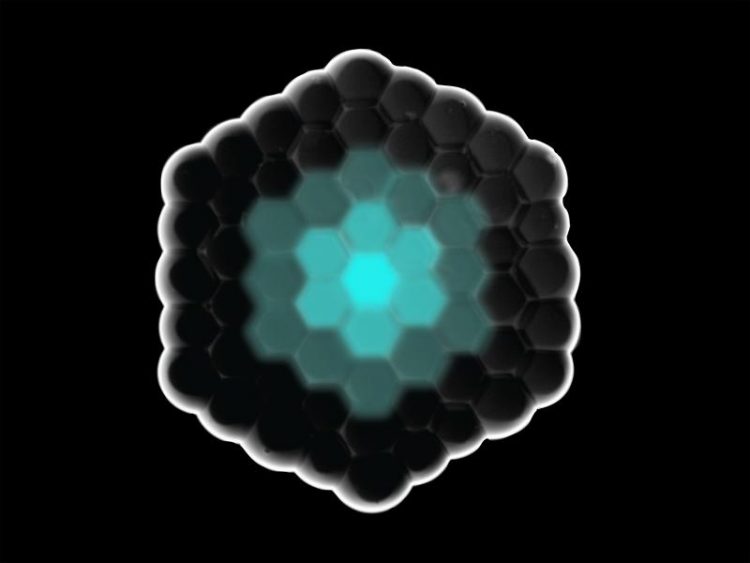Artificially produced cells communicate with each other: Models of life

Signal molecules (blue) spread in the artificial cell structure and allow communication through the membranes. Image: A. Dupin / TUM
Scientists around the world are working on creating artificial, cell-like systems that mimic the behavior of living organisms. Friedrich Simmel and Aurore Dupin have now for the first time created such artificial cell assemblies in a fixed spatial arrangement. The highlight is that the cells are able to communicate with each other.
“Our system is a first step towards tissue-like, synthetic biological materials that exhibit complex spatial and temporal behavior in which individual cells specialize and differentiate themselves, not unlike biological organisms,” explains Friedrich Simmel, Professor of Physics of Synthetic Biosystems (E14) at TU Munich.
Gene expression in a fixed structure
Gels or emulsion droplets encapsulated in thin fat or polymer membranes serve as the basic building blocks for the artificial cells. Inside these 10 to 100 micron sized units, chemical and biochemical reactions can proceed uninhibited.
The research team used droplets enclosed by lipid membranes and assembled them into artificial multicellular structures called “micro-tissues”. The biochemical reaction solutions used in the droplets can produce RNA and proteins, giving the cells a of a kind of gene expression ability.
Signal exchange and spatial differentiation of cells
But that's not all: Small “signal molecules” can be exchanged between cells via their membranes or protein channels built into the membranes. This allows them to temporally and spatially couple with each other. The systems thus become dynamic – as in real life.
Chemical pulses thus propagate through the cell structures and pass on information. The signals can also act as triggers, allowing initially identical cells to develop differently.
“Our system is the first example of a multicellular system in which artificial cells with gene expression have a fixed arrangement and are coupled via chemical signals. In this way, we achieved a form of spatial differentiation, “says Simmel.
Models, mini factories and microsensors
Developing these kinds of synthetic systems is important since they allow scientists to investigate fundamental questions about the origins of life in a model. Complex organisms became possible only after cells began specializing and distributing work between cooperating cells. How this came about is among the most fascinating questions in basic research.
Using a modular construction kit of tailor-made cell systems, the researchers hope to simulate various properties of biological systems in the future. The idea is that cells react to their environment and learn to act independently.
The first applications are already on the horizon: In the long term, artificial cell assemblies can be deployed as mini-factories to produce specific biomolecules, or as tiny micro-robot sensors that process information and adapt to their environments.
Cells from a 3-D printer
Friedrich Simmel and Aurore Dupin still assemble their cell systems manually using micromanipulators. In the future, however, they plan to cooperate with the Munich University of Applied Sciences, for example, to systematically build larger and more lifelike systems using 3-D printing technology.
Further information:
This work was funded by the European Research Council and the DFG Cluster of Excellence Nanosystems Initiative Munich (NIM). Aurore Dupin was supported by the DFG Research Training Group “Chemical Foundations of Synthetic Biology”.
Prof. Dr. Friedrich C. Simmel
Technical University of Munich
Physics of Synthetic Biological Systems
Am Coulombwall 4a, 85748 Garching, Germany
Tel.: +49 89 289 11610 – E-Mail: simmel@tum.de
Web: http://www.e14.ph.tum.de/en/home/
Signalling and differentiation in emulsion-based multi-compartmentalized in vitro gene circuits
Aurore Dupin and Friedrich C. Simmel
Nature Chemistry, 26.11.2018 – DOI: 10.1038/s41557-018-0174-9
Link: https://www.nature.com/articles/s41557-018-0174-9
Nature “Behind the paper”: https://chemistrycommunity.nature.com/users/189114-aurore-dupin/posts/40976-sign…
Nature “News & Views”: https://www.nature.com/articles/s41557-018-0192-7
https://www.tum.de/nc/en/about-tum/news/press-releases/detail/article/35181/ Link to the press release
Media Contact
All latest news from the category: Life Sciences and Chemistry
Articles and reports from the Life Sciences and chemistry area deal with applied and basic research into modern biology, chemistry and human medicine.
Valuable information can be found on a range of life sciences fields including bacteriology, biochemistry, bionics, bioinformatics, biophysics, biotechnology, genetics, geobotany, human biology, marine biology, microbiology, molecular biology, cellular biology, zoology, bioinorganic chemistry, microchemistry and environmental chemistry.
Newest articles

Bringing bio-inspired robots to life
Nebraska researcher Eric Markvicka gets NSF CAREER Award to pursue manufacture of novel materials for soft robotics and stretchable electronics. Engineers are increasingly eager to develop robots that mimic the…

Bella moths use poison to attract mates
Scientists are closer to finding out how. Pyrrolizidine alkaloids are as bitter and toxic as they are hard to pronounce. They’re produced by several different types of plants and are…

AI tool creates ‘synthetic’ images of cells
…for enhanced microscopy analysis. Observing individual cells through microscopes can reveal a range of important cell biological phenomena that frequently play a role in human diseases, but the process of…





















